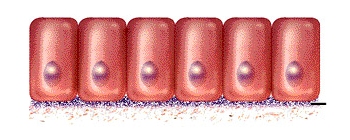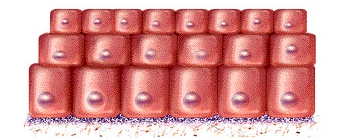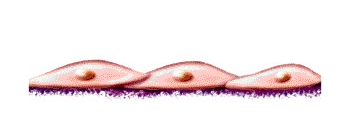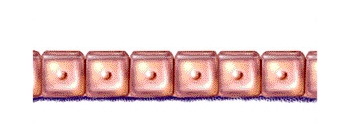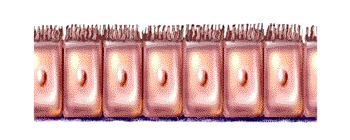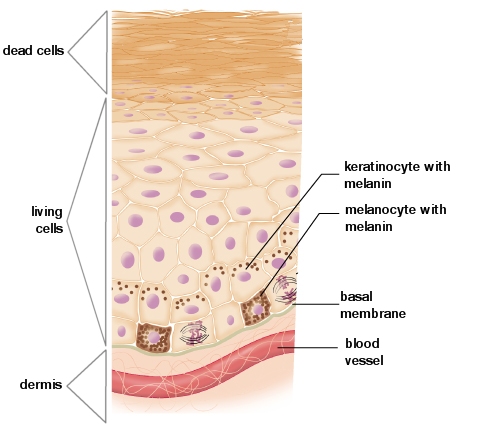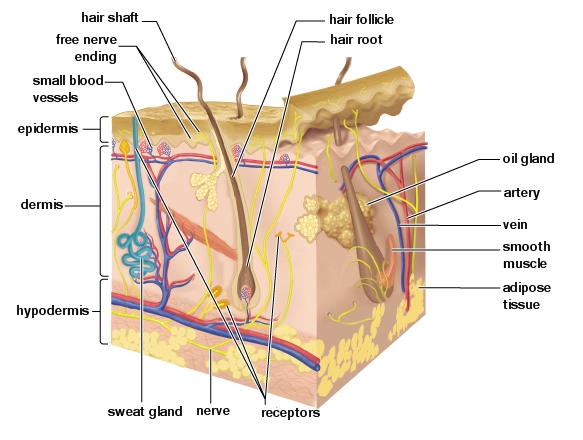Skin
Function and Structure
The skin is an organ because it is an aggregation of tissues that perform a specific function. The skin and its derivative, e.g. hat, nails, glands and receptors, make up the integumentary system of the body.
Function
- Protection of tissues from mechanical injury and abrasion.
- Protection of tissues from chemicals.
- Protection of tissues from ultra-violet radiation.
- Prevents microbial invasion.
- Prevents dessication.
- Prevents excessive loss of inorganic and organic materials.
- Stores chemical compounds.
- Allows controlled water loss by evaporation to facilitate temperature regulation.
- Allows excretion of various salts, ions and toxins.
- Facilitates temperature regulation by changes in its blood flow.
- Allows absorption of various chemicals.
- It is a sensory receptor.
- It is the site of vitamin D production.
Structure
Epithelium exists in the following forms:
Epidermis (comprised of epithelium)
- Germinative layer - stratum germinativum
This essentially consists of two layers:
- stratum basale is a continuous single layer of cuboidal to columnar epithelial cells which actively divide producing fresh epidermis.
- stratum spinosum contains 8-10 rows of polyhedral (many sided) cells that fit closely together.
Melanocytes are found just below or between the cells of the stratum basale. Infolding of the germinative layer produce sweat glands, sebaceous glands, hair follicles and fingernails. This layer has no blood supply and thus derives oxygen and nutrients by diffusion or active transport from the capillary network of the dermis.
- Granular layer - stratum granulosum
This comprises 3-5 layers of young/new cells recently derived from the germinative layer. These cells eventually become keratinised, lose their nuclei, flatten and are gradually pushed to the skin surface.
- stratum lucidum
This layer is only found in thick skin. It consists of several rows of translucent, flat, dead cells.
- Cornified layer - stratum corneum
This is the wear and tear outer layer which forms a waterproof, protective barrier. It consists of 25-30 rows of dead flat cells. It may be particularly thickened in non-hairy skin e.g. palms of the hands, soles of the feet.
Non-hairy skin also has a thick epidermis with regular patterns or ridges (fingerprints) and a thin dermis with numerous sweat glands and few hair follicles. Hairy skin has a thin epidermis with a thicker dermis with numeroushair follicles and covers most of the rest of the body.
Dermis (non-cellular)
This layer comprises largely connective tissue containing collagen bundles and a few elastic fibres (which degenerate with age). There are relatively few cells present except for fibroblasts which are important in wound healing and macrophages.
There are two layers:
- Papillary layer
Approximately 20% of the thickness. This layer contains capillary loops and Messner's corpuscles (tactile).
- Reticular layer
This is dense irregularly arranged connective tissue. Spaces between the fibres are occupied by small amounts of adipose tissue, hair follicles, nerve endings, sebaceous glands, blood apillaries, lymphatic vessels and sweat glands.
These all appear in the dermis but are produced in the epidermis. Dermis tends to be thicker on the dorsal part of the body, cf. Ventral. Dermis tends to be thicker on the lateral aspects of extremities cf. Medial.
Subcutaneous layer
This layer consists of areolar and adipose tissue.
Fibres from the dermis extend down into the subcutaneous layer, anchoring the skin to it. This is itself attached to the underlying tissues and organs.
- Subcutaneous fat
This is the layer beneath the dermis in which fat is stored. This has a number of functions viz. protection, body shape, insulation and as an energy store.
Associated Structures (Skin derivatives)
Sweat Glands (odiferous glands)
Coiled tubes consisting of secretory cells which absorb fluid from the surrounding cells and capillaries and pass this into the tube. There are two types:
- Apocrine glands - found in the axilla, pubic regions and areolae of the breast. These become active after puberty, produce more viscous secretion and have a sexual/social function.
- Eccrine glands - these are far more common and distributed throughout the skin except for the lip margins, nail beds, glans penis, glans clitoris and eardrums. They are particularly important in temperature regulation and are especially numerous on the palms of the hands, soles of the feet and the armpits. The composition of eccrine sweat varies but it consists mainly of water with dissolved salts, mainly NaCl (0.3%), Urea (0.03%), Uric acid, Ammonia, Amino acids, Sugar, Ascorbic acid and toxins including Lactic acid (0.07%).
Ceruminous Glands
These are modified odiferous glands which open directly into the ear canal. The combined secretions of ceruminous and sebaceous glands is called cerumen - ear wax. The combination of hairs and cerumen help keep objects from entering the ear.
Sebaceous Glands
These open mainly into the hair follicles and produce the oily secretion sebum which gives hairs water repelling properties, keeps epidermis supple and waterproof (and therefore reduces the tendency for it to become dry through evaporation). They vary in size and shape in various body regions, e.g. small in the trunk and extremities and large in the face, neck, upper chest and breasts. Some sebaceous glands open directly onto the skin, e.g. lips, labia minor, glans penis and meibomian glands of the eyelids. The fatty acids present in sebum may prevent multiplication of pathogenic bacteria and fungi.
Capillaries
These supply the skin with the necessary food and oxygen and remove its metabolic waste. They also play a vital role in temperature control.
Hair Follicles
This is a deep pit of granular and germinative layers whose cells multiply and build up a cylindrical hair inside the follicle. The cells of the hair become impregnated with keratin and then die. The constant adding of new cells to the base of the hair causes it to grow. Hairs on the head grow for up to four years after which they fall out and are replaced. Body hair grows for only a few months. The colour of hair depends on the amount of melanin present. The curliness depends on the shape of its cross-section; circular: straight hari, elliptical: wavy hair, flattened/kidney shaped: woolley hair. Contraction of the erector papillae muscles compresses the sebaceous gland forcing sebum onto the skin.
Fingernails
This is modified granular layer produced by a groove lined with germinative cells. They grow at a rate of approximately 0.5mm per week.
Nerve Endings
The skin contains a variety of sensory nerve endings which are responsive to a variety of different stimuli:
- Free nerve endings - pain
- Meissners' corpuscles - touch
- Merkel's discs - touch
- Pacinian corpuscles - pressure
- Hair plexus - touch or pain
